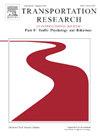准备好转变了吗?在要求干预有条件自动驾驶时,将驾驶员带回循环的策略
IF 3.5
2区 工程技术
Q1 PSYCHOLOGY, APPLIED
Transportation Research Part F-Traffic Psychology and Behaviour
Pub Date : 2025-02-17
DOI:10.1016/j.trf.2025.02.014
引用次数: 0
摘要
技术进步和监管努力使汽车制造商能够有条件地向市场推出自动驾驶系统。这些系统允许驾驶员暂时脱离驾驶任务。然而,只要系统不是完全自动化的,不同级别的自动化之间的转换是必要的,这意味着驾驶员的角色和责任的转变。例如,在系统限制的情况下,注意力不集中或分心可能会损害驾驶员安全接管的能力。因此,本研究研究了两种过渡策略——监测环境和启动机动——在请求干预3级自动驾驶系统(也称为接管请求)期间将驾驶员带回环路并确保安全驾驶性能的影响。此外,这些策略可以用于在向较低自动化水平过渡期间保持驾驶员在环路中,而无需手动接管。例如,当所需的驾驶动作违反交通规则时。在一项驾驶模拟器研究中,36名参与者在农村道路上经历了有条件的自动驾驶。当参与者执行一项与驾驶无关的任务(NDRT)时,自动驾驶系统接近了一起追尾事故,该事故阻塞了车辆的车道。在试验中,该系统要求驾驶员要么监控交通场景,要么决定何时启动规避动作。根据交通法规(是否存在超车禁令),系统无法解决并发出干预请求,或者系统可以自行执行规避机动。这导致了2 × 2的受试者内部设计,转换策略(监测,启动)和转换类型(请求干预,不请求干预)作为独立变量。这些过渡策略都没有提高驾驶性能、缩短接管时间或影响驾驶员的注视行为。过渡类型影响了监测试验中的信任:当监测之后没有干预请求时,对自动驾驶系统的信任下降。根据两种策略对不同过渡环境的适用性,讨论了结果。本文章由计算机程序翻译,如有差异,请以英文原文为准。
Ready to transition? Strategies to bring drivers back into the loop upon requests to intervene in conditionally automated driving
Technology advances and regulatory efforts allow car manufacturers to introduce conditionally automated driving systems into the market. These systems permit drivers to temporarily disengage from the driving task. However, as long as systems are not fully automated, transitions between different levels of automation are necessary and imply shifts in the driver's role and responsibilities. For example, inattention or distraction may impair the driver's ability to take over safely in the case of system limits. Therefore, this work investigates the effect of two transition strategies - monitoring the environment and initiating a maneuver - on bringing drivers back into the loop and ensuring safe driving performance during requests to intervene in Level 3 automated systems (also referred to as take-over requests). Additionally, these strategies could be employed to keep drivers in and on the loop during transitions to lower levels of automation without requiring a manual take-over. For example, when a required driving maneuver would violate traffic rules. In a driving simulator study, 36 participants experienced a conditionally automated drive on a rural road. While participants performed a non-driving-related task (NDRT), the automated driving system approached a rear-end collision blocking the vehicle's lane. In experimental trials, the system requested drivers either to monitor the traffic scene or to decide when to initiate an evasive maneuver. Depending on traffic regulations (overtaking ban present or absent), the system could not solve the situation and issued a request to intervene, or the system could perform the evasive maneuver itself. This resulted in a 2 x 2 within-subjects design with transition strategy (monitoring, initiating) and transition type (request to intervene, no request to intervene) as independent variables. None of the transition strategies improved driving performance, shortened take-over time or affected drivers' gaze behavior. The transition type affected trust in monitoring trials: when monitoring was not followed by a request to intervene, trust in the automated driving system decreased. Results are discussed in light of the suitability of both strategies for different transition contexts.
求助全文
通过发布文献求助,成功后即可免费获取论文全文。
去求助
来源期刊
CiteScore
7.60
自引率
14.60%
发文量
239
审稿时长
71 days
期刊介绍:
Transportation Research Part F: Traffic Psychology and Behaviour focuses on the behavioural and psychological aspects of traffic and transport. The aim of the journal is to enhance theory development, improve the quality of empirical studies and to stimulate the application of research findings in practice. TRF provides a focus and a means of communication for the considerable amount of research activities that are now being carried out in this field. The journal provides a forum for transportation researchers, psychologists, ergonomists, engineers and policy-makers with an interest in traffic and transport psychology.

 求助内容:
求助内容: 应助结果提醒方式:
应助结果提醒方式:


